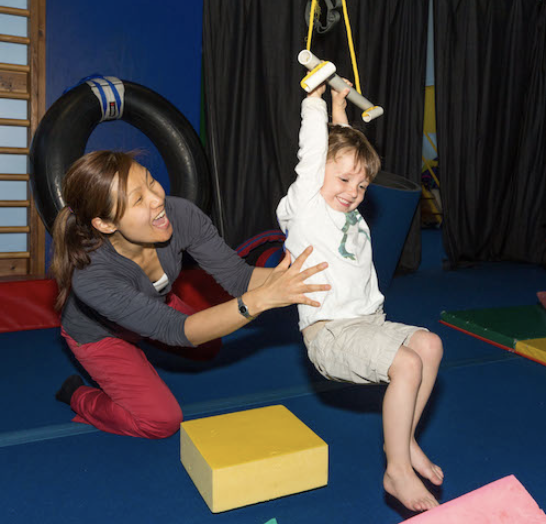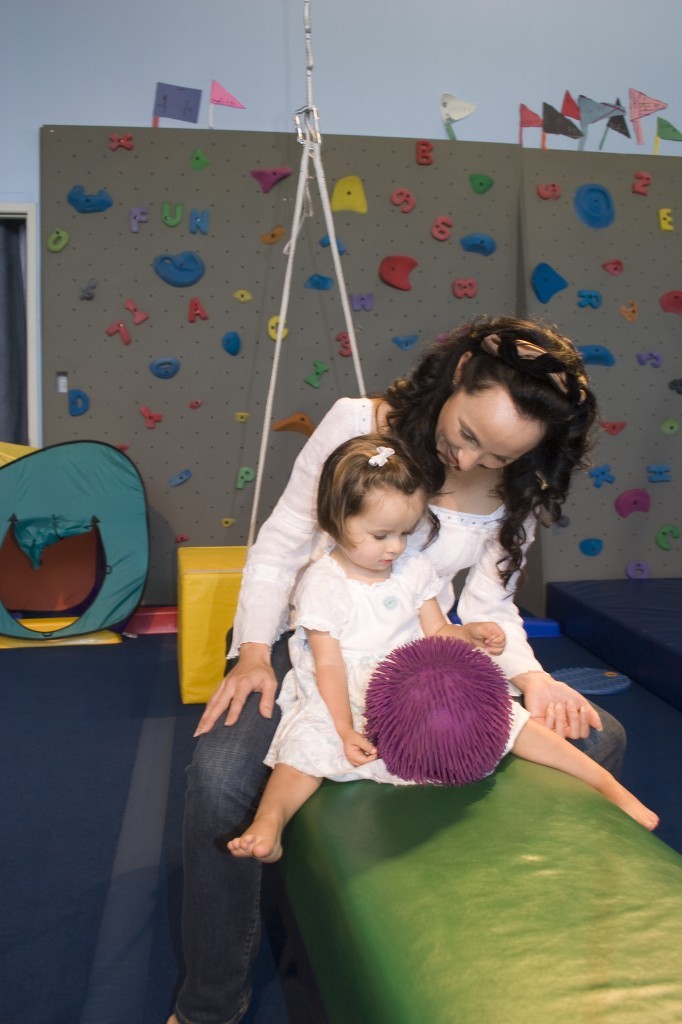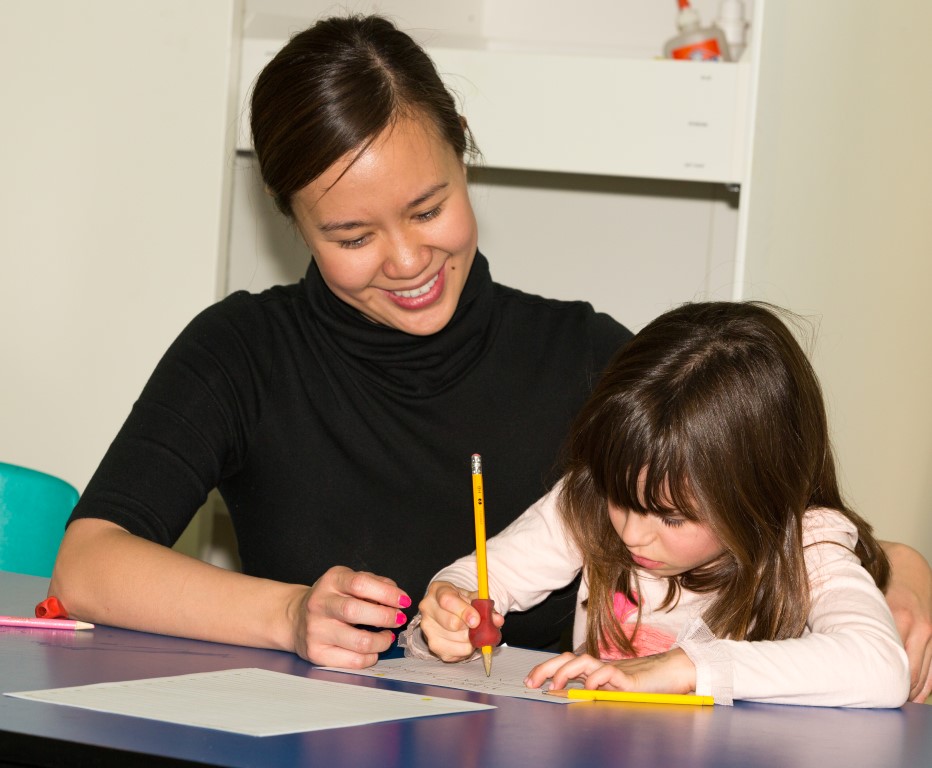Occupational therapists
What Your Child May Experience in an Occupational Therapy Session
An occupational therapy session is work for a child’s brain, disguised as play.
A child’s “occupations” include everything he or she does throughout the day – the “jobs of childhood” – the most important jobs being playing, socializing, and learning. The purpose of pediatric occupational therapy is to help a child become comfortable, independent, and proficient in these areas of their lives.
 Occupational therapy addresses a variety of areas of deficits including fine motor skills, gross motor skills, social emotional skills and sensory integration. Initial therapy sessions help the therapist to understand the unique wiring of the individual child’s brain and nervous system. The therapist will consult with the child’s parents to ascertain what home and school life are like for the child, and what they have observed in their child’s development. This evaluation and analysis process will continue across subsequent sessions as the child’s nervous system develops.
Occupational therapy addresses a variety of areas of deficits including fine motor skills, gross motor skills, social emotional skills and sensory integration. Initial therapy sessions help the therapist to understand the unique wiring of the individual child’s brain and nervous system. The therapist will consult with the child’s parents to ascertain what home and school life are like for the child, and what they have observed in their child’s development. This evaluation and analysis process will continue across subsequent sessions as the child’s nervous system develops.
Each occupational therapy session is tailored to meet the child’s specific needs, facilitated in a warm and comfortable environment, and created to reflect the child’s interests.
Sensory processing, or organizing, is how a child learns and experiences the world around him. “Just right” sensory experiences during the therapy session will help the child with emotional regulation, self-regulation and social engagement. Intact sensory integration provides the fundamental building blocks for attention, emotional development, motor skills development and higher-level academics and social skills.
An occupational therapy session, utilizing a sensory integration treatment approach, will often target the social-emotional system, employing the Zones of Regulation, Floortime and Social Thinking® (Attributed to Michelle Garcia Winner as creator of the Social Thinking Methodology) programs. Covered would be social skills concepts such as staying with the group, taking turns, collaborative play, and interacting with peers and adults, in order for children to be successful in relationships and group environments.
 Occupational therapy may work on fine motor skills such as grasp and in-hand manipulation, necessary for drawing, coloring, folding and cutting. Visual motor integration, the ability to use the visual system and the fine or gross motor systems together, and essential to activities such as handwriting, ball play and sports, may be addressed.
Occupational therapy may work on fine motor skills such as grasp and in-hand manipulation, necessary for drawing, coloring, folding and cutting. Visual motor integration, the ability to use the visual system and the fine or gross motor systems together, and essential to activities such as handwriting, ball play and sports, may be addressed.
An OT session might include work on gross motor skills that are involved in playing sports that require bilateral coordination, ball skills, strength, coordination and balance. The therapist will provide easy and creative activities and exercises to help increase upper body and core strength necessary for postural stability, balance, coordination, gross and fine motor control and will often provide a home-based program for follow through.
Often, children who struggle with Sensory Integration and are referred to Occupational Therapy have challenges with Executive Function Skills, necessary for learning and development. In order for a child to plan and organize what they need to do throughout the day, such as getting homework done, they need to be able to focus attention, filter distractions, remember and perform multi-step directions.
Occupational therapy is work for a child’s brain, disguised as play. All children engaged in occupational therapy experience a new level of confidence and self-esteem that comes with learning a new skill or overcoming a challenge. The smile on their face will say it all.
This program, including its teacher or leader, is not affiliated with, nor has it been reviewed, approved, or endorsed by Michelle Garcia Winner and Think Social Publishing, Inc.
Handwriting – Dying Art or Important Skill?
Is handwriting a dying art or is it still an important skill to master?
“My child’s handwriting is illegible. Do I need to do anything about this? Why do many children struggle with handwriting legibility? Does my child really need to learn handwriting?”
There has been some discussion recently about the viability and necessity of learning penmanship skills. Yet research shows that writing by hand engages the brain and is a vital component of literacy. Since handwritten testing throughout the school system is unlikely to change any time soon, learning to write quickly and clearly is an important means to an end. With the adoption of the Common Core State Standards, the emphasis and expectations placed on classroom note-taking and expository writing in grades K–5 is greater than ever.
Whether a child prints or uses cursive writing, it must be legible to convey correct test answers, thoughts, instructions, etc. throughout his academic career and life. Therefore “hand writing” is a skill that must be learned and serves many purposes besides legibility.
While we may take the ability to write correctly for granted, many support skills must first be learned requiring the hand, eyes and brain to work in harmony. This becomes more challenging when a child is experiencing a delay in certain areas of development. This in turn can leave a child with feelings of frustration, decreased confidence and success, and often results in avoidance of the very repetition necessary to build skill.
The years between the ages of 3 and 5 are the time your child will build the motor coordination required to develop the dexterity, hand strength and endurance to shift from a fisted grasp to an adult 3 finger, (tri-pod) dynamic grasp that will allow them to control the pencil with ease.
In order to successfully engage in the Kindergarten curriculum, the foundations for a successful pencil grasp and control need to be in place. Core strength for body control to sit up right and arm strength to hold the paper still and stabilize the writing arm need to be well developed before the art of learning handwriting can occur. Their eyes need to work together to hold a focal point and track and be ready to shift gaze across the paper and from the board to the paper and back with ease. The visual memory system needs to be strong to retrieve the images of letters and begin to make sense of what they are seeing by adding meaning through the matching of sounds with each symbol. Reading and handwriting are a partnership – when one grows the other gets supported.
So why do some children struggle with handwriting and how do we help them?
When this very complicated neurological process has a hard time coming together, a child can be left with feelings of frustration and decreased confidence. Fundamental skills are often learned in the form of play for children and not work. They are driven to continue activities by feeling good and having fun. When the activities in the preschool years such as cutting, drawing, beading, climbing and catching a ball are not easy for them they often have the choice to avoid them, thus not engaging in the repetition actually needed to master the skill.
Teachers and parents may not notice that the child is avoiding these types of play especially if the child is exceptionally verbal and engaging. As adults, we need to be aware that children need to have healthy exposure to activities that will develop their nervous systems during the pre-school years in preparation for activities such as handwriting.
How do I know if my child will get past his difficulties?
Development is an individual process as each child has their own unique brain and their own sets of natural gifts and challenges. When engaging in general activities, parents and teachers can help children by:
- Making the child feel emotionally safe and excited to engage in the activities they may want to avoid.
- Grade the activity down to a level the child can easily engage in.
- Keep the activity as child driven as possible.
- If you are struggling to work with your child consult an Occupational Therapist. OT’s are highly trained in assessing the foundational neurological processes that are the base for all play and learning. They are able to let teachers and parents know if the struggle is rooted in lack of exposure, a mild delay that will catch up on its own, or truly an inefficient processing system that needs guidance and the right support to spring board into a positive outcome.
- If in doubt, ask.
Simple things you can do to help your child with his handwriting skills:
- Make sure your child is seated in a chair and at a table that allows for an upright posture with their feet firmly on the floor. Keep the ankles, knees and hips bent at approximately 90 degrees.
- Encourage the non-dominant hand to support the paper.
- Take a small cotton ball and place it under the 4th and 5th digits and secure it into the palm to help build the separation of the 2 sides of the hand to increase pencil grasp.
- Play bouncing, throwing at a target and catching games.
- Draw letters on each other’s back and try to guess the letters.
If left un-monitored, children may begin to:
- Have a negative relationship with learning
- Write a few words instead of the many ideas and thoughts they would like to share
- Have decreased confidence and self-image related to written work.
- Spend valuable brain energy on the handwriting process instead of the thoughts and ideas and learning process
Handwriting should be fun and requires the whole brain and the whole body.
The “Handwriting Club” at Child Success Center is a program customized to meet each child’s needs. Program is designed and run by licensed and highly skilled Occupational Therapists and features multi-sensory strategies, whole brain learning, and the extremely successful Handwriting Without Tears® program.
For more details or to enroll, call Child Success Center at 310/899-9597 or e-mail: enroll@childsuccesscenter.com
Related articles:
Teachers Still See Need for Cursive Writing


